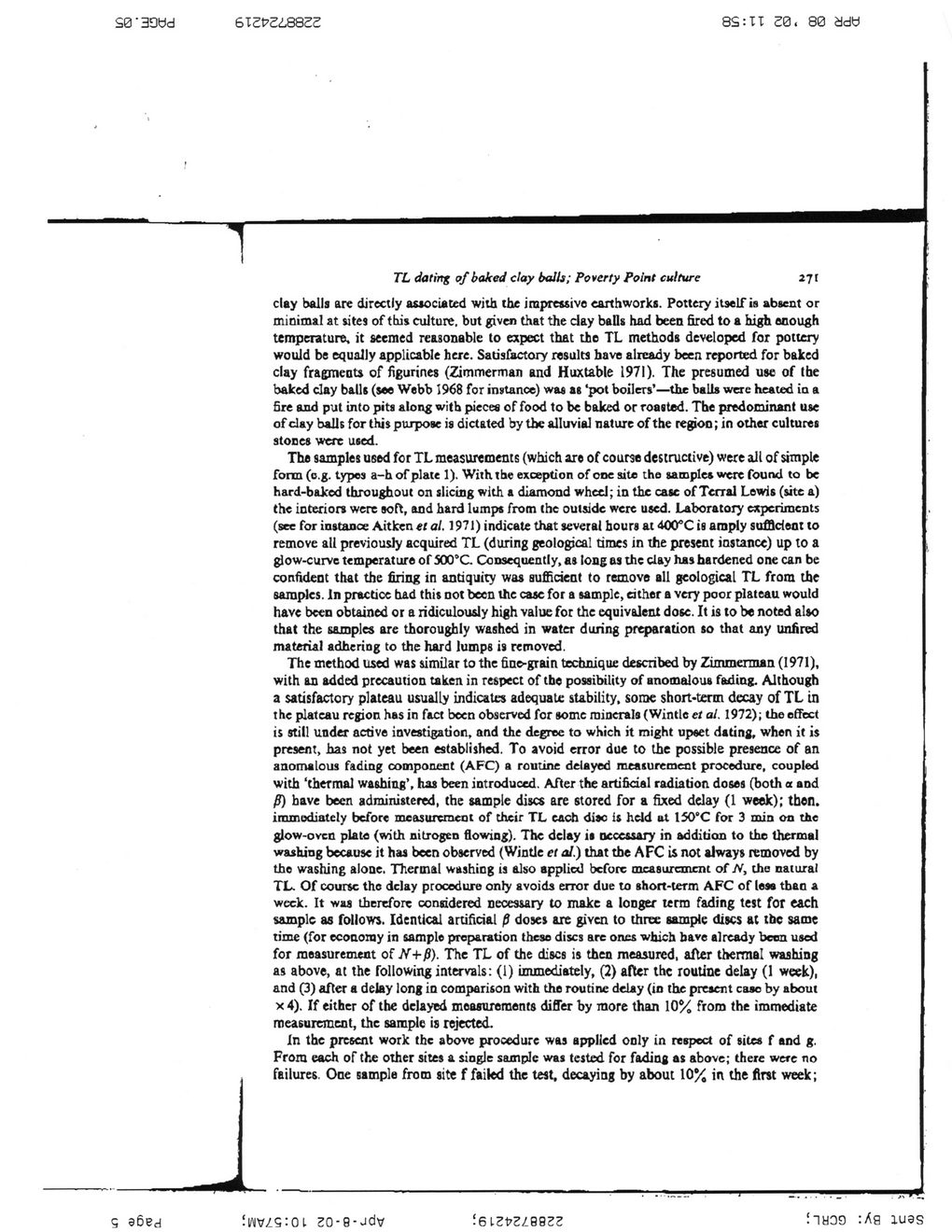This text was obtained via automated optical character recognition.
It has not been edited and may therefore contain several errors.
sa'BObd 6I2t?2i8822 8S:TT 20, 80 ddU 1 TL dating of baked clay balls; Poverty Point culture 27t clay balls are directly associated with the impressive earthworks. Pottery itself is absent or minimal at sites of this culture, but given that the day balls had been fired to a high enough temperature, it seemed reasonable to expect that the TL methods developed for pottery would be equally applicable here. Satisfactory results have already been reported for baked clay fragments of figurines (Zimmerman and Huxtable 1971). The presumed use of the baked clay balls (see Webb 1968 for instance) was as ‘pot boilers’—the balls were heated in a fire and put into pits along with pieces of food to be baked or roasted. The predominant use of day balls for this purpose is dictated by the alluvial nature of the region; in other cultures stones were used. The samples used for TL measurements (which are of course destructive) were all of simple form (e.g. types a-h of plate 1). With the exception of one site the samples were found to be hard-baked throughout on slicing with a diamond wheel; in the ease of Terral Lewis (site a) the interiors were soft, and hard lumps from the outside were used. Laboratory experiments (see for instance Aitken el al. 1971) indicate that several hours at 400°C is amply sufficient to remove all previously acquired TL (during geological times in the present instance) up to a glow-curvc temperature of 300°C Consequently, as long as the day has hardened one can be confident that the firing in antiquity was sufficient to remove all geological TL from the samples, in practice had this not been the case for a sample, either a very poor plateau would have been obtained or a ridiculously high value for the equivalent dose. It is to be noted also that the samples are thoroughly washed in water during preparation so that any unfired material adhering to the hard lumps is removed. The method used was similar to the fine-grain technique described by Zimmerman (1971), with an added precaution taken in respect of the possibility of anomalous fading. Although a satisfactory plateau usually indicates adequate stability, some short-term decay of TL in the plateau region has in fact been observed for some minerals (Wintle et al. 1972); the effect is still under active investigation, and the degree to which it might upset dating, when it is present, has not yet been established. To avoid error due to the possible presence of an anomalous fading component (AFC) a routine delayed measurement procedure, coupled with ‘thermal washing’, has been introduced. After the artificial radiation doses (both a and P) have been administered, the sample discs are stored for a fixed delay (1 week); then, immediately before measurement of their TL each disc is held at 150°C for 3 min on the glow-ovcn plate (with nitrogen flowing). The delay is accessary in addition to the thermal washing because it has been observed (Wintle et al.) that the AFC is not always removed by the washing alone. Thermal washing is also applied before measurement of N, the natural TL. Of coursc the delay procedure only avoids error due to short-term AFC of lea* than a week. It was therefore considered necessary to make a longer term fading test for each sample as follows. Identical artificial p doses are given to three sample discs at the same time (for economy in sample preparation these discs are ones which have already been used for measurement of N+p). The TL of the discs is then measured, after thermal washing as above, at the following intervals; (1) immediately, (2) after the routine delay (1 week), and (3) after a delay long in comparison with the routine delay (in the present case by about x4). If either of the delayed measurements differ by more than 10% from the immediate measurement, the sample is rejected. In the present work the above procedure was applied only in respect of sites f and g. From each of the other sites a single sample was tested for fading as above; there were no failures. One sample from site f failed the test, decaying by about 10% in the first week; „ if 5 s6ed !iaiw_s:ol 20-9-Jdv ■ "IH39 :Aa 1U3S

Claiborne Historical Site Archaeometry-Pp-269-275-(04)